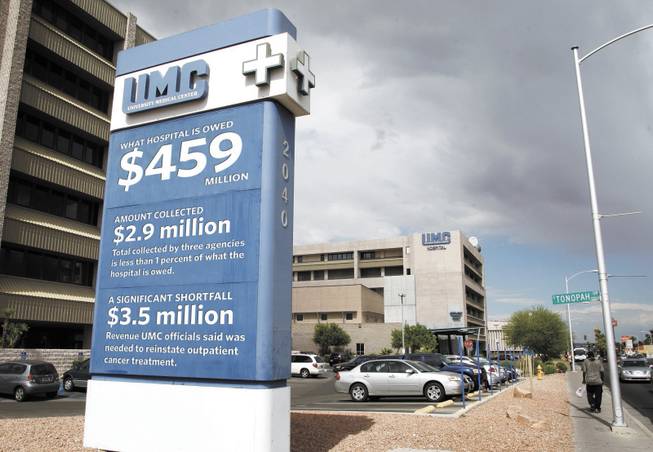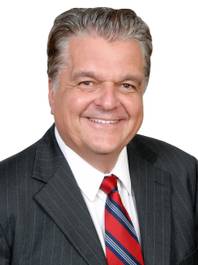
Photo: Steve Marcus / Las Vegas Sun; Las Vegas Sun Photo Illustration
Wednesday, July 1, 2009 | 2 a.m.

Steve Sisolak
Sun Archives
- Grant to restore cancer programs at UMC (5-28-2009)
- Editorial: Possible relief for UMC (4-14-2009)
- Fighting for its life, UMC program loses patient (4-14-2009)
- Bill to open UMC cancer OK'd on party lines (4-9-2009)
- A black eye in medicine brings posturing, again (4-9-2009)
- UMC CEO: Bill to open cancer center doesn't address funding (4-8-2009)
- State measure could force closure of UMC, county says (3-31-2009)
- UMC might benefit from a hospital taxing district (1-18-2009)
University Medical Center is collecting less than 1 percent of its past-due bills, a situation that one county commissioner said needs to be quickly addressed to turn around the financially troubled public hospital.
Of the $459 million in past-due debt UMC was owed between October and May, its three collection agencies recovered just $2.9 million, or 0.6 percent, from former patients.
Commissioner Steve Sisolak, who began asking questions about the hospital’s debt collection practices because of its ongoing financial problems, said raising that rate by a few percentage points would bring in millions to avoid the embarrassing cuts in services the hospital has endured in recent months.
“It just seems unbelievable to me,” Sisolak said. “Why is it so low? It doesn’t make sense.”
UMC couldn’t provide details this week on how much of the debt resulted from treating uninsured and indigent patients, which is part of its mission as a publicly funded hospital.
But the International Association of Credit and Collections said its members reported in 2006 an average collection rate of 15.2 percent on unpaid hospital bills. John Nemo, the association’s spokesman, said the figure includes both private and not-for-profit hospitals like UMC, which typically treat a higher percentage of uninsured and indigent patients.
Increasing UMC’s collection to that industry average would bring in about $46 million, after agency fees.
In an e-mail to the Sun, UMC spokesman Rick Plummer said the hospital bills patients four times. If patients don’t pay, UMC then offers a discount to uninsured individuals who are Clark County residents and tries to work out payment plans, he said. If those efforts fail, the debt is turned over to a collection agency, according to Plummer.
UMC was unable to answer additional questions about the uncollected debt, including how long the $459 million had accrued.
Among the issues Sisolak wants to investigate further is whether the hospital staff is held accountable for inaccurate or incomplete paperwork that results in unpaid bills, what legal recourse, such as liens, is used to recover the money and if it’s made clear to patients that they are expected to pay for services.
“I’m not advocating going after senior citizens or those who clearly can’t afford to pay,” he said. “But does everyone out there figure they don’t have to pay when they come to UMC?”
UMC’s financial troubles led to the closure late last year of its outpatient oncology unit, in part to offset a 5 percent cut in state Medicaid reimbursements. The TV news magazine program “60 Minutes” reported on the closure in April, bringing an intense focus on the hospital’s budget deficit and prompting an effort in the Legislature to force the county to reopen the program.
The Lincy Foundation recently donated $3 million, which will allow the outpatient cancer unit to reopen.
At least one person who used to collect UMC’s past due debts said the hospital should be recovering more money from its former patients. Duane Christy, owner of Aargon Collection Agency, said his business was collecting about 23 percent of the hospital’s debt when it first began contracting with UMC in 1999. The rate dropped to about 10 percent in 2003, but the work involved bills that had been picked over by another collection agency, what’s known in the industry as “secondary debt.”
“I’m not here to bash UMC,” said Christy, who ran unsuccessfully last year for the County Commission seat held by Sisolak. “I’m just tired of seeing the county hospital lose money it doesn’t have to lose. I want to see that hospital survive.”
Christy said one of his clients is a private hospital in Las Vegas for which he recovers 9 percent of its secondary debt.
Without knowing the status of University Medical Center’s $459 million in unpaid bills, Christy said if it is “prime paper” — bills that haven’t yet gone to a collection agency — the agencies should be able to collect 15 percent.
Sisolak said he wants to see if it’s possible for UMC to come close to that figure.
“I just want some answers,” he said. “Because ultimately the taxpayer is getting hit again here and we need to come up with ways to stop that.”

Join the Discussion:
Check this out for a full explanation of our conversion to the LiveFyre commenting system and instructions on how to sign up for an account.
Full comments policy